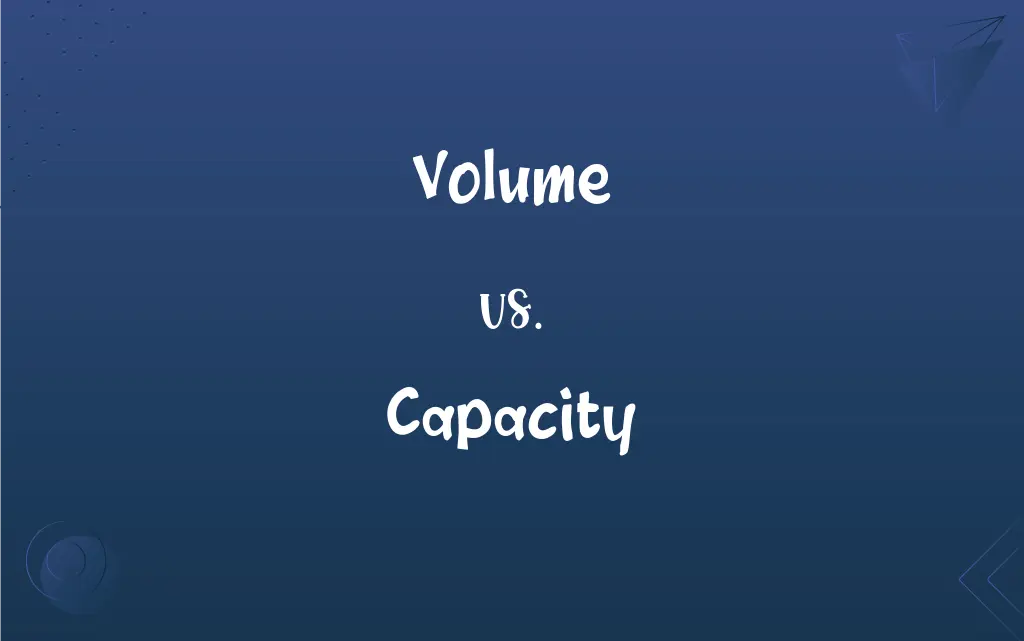Volume vs. Capacity: What's the Difference?
Edited by Aimie Carlson || By Harlon Moss || Updated on October 24, 2023
Volume refers to the amount of space an object occupies, while capacity indicates the maximum amount something can contain or produce.

Key Differences
Volume is a measure of the space taken up by an object, whether solid, liquid, or gas. Capacity, on the other hand, refers to the potential or maximum amount that a container or system can hold.
In everyday language, one might consider volume when thinking about the size of a book or the sound level of music. In contrast, capacity would be more relevant when considering how much water a bottle can hold.
Scientifically, volume is used to measure the three-dimensional space an entity occupies. Capacity is concerned with the maximum potential or limit of something, often in terms of containment.
Volume can be constant for solid objects, but for containers, it represents their total possible filled space. Capacity indicates the upper limit of how much a container can hold without overflowing.
For example, the volume of a cube is calculated by multiplying its length, width, and height. The capacity of a water tank, however, would tell us the maximum amount of water it can store.
ADVERTISEMENT
Comparison Chart
Definition
Amount of space an object occupies.
Maximum amount something can contain or produce.
Application
Often applied to solid, liquid, and gas entities.
Typically related to containers or systems.
Measure of
Space occupied by an object.
Upper limit or potential of containment.
Contextual Example
The volume of a sound or a publication.
The capacity of a venue or a hard drive.
Associated with Overfilling
Volume doesn't imply overfilling or reaching a limit.
Exceeding capacity implies overfilling or going beyond the limit.
ADVERTISEMENT
Volume and Capacity Definitions
Volume
Volume is the quantity or power of sound.
The speaker emitted a high volume of noise.
Capacity
Capacity refers to the ability or power to do or understand something.
She has a great capacity for understanding complex theories.
Volume
Volume denotes a book forming part of a work or series.
I'm reading the third volume of the series.
Capacity
Capacity indicates the total amount a facility can produce.
The factory has a production capacity of 1000 units per day.
Volume
Volume represents the magnitude or extent of something.
The sheer volume of data was overwhelming.
Capacity
Capacity is the maximum amount that something can contain.
The bottle has a capacity of 2 liters.
Volume
Volume is the amount of space that a substance or object occupies.
The volume of this box is 3 cubic feet.
Capacity
Capacity pertains to the potential for achieving, producing, or understanding.
Our team has the capacity to complete the project on time.
Volume
Volume refers to the loudness or intensity of a sound.
Please lower the volume on the television.
Capacity
Capacity is the official role or position someone holds.
He attended the meeting in his capacity as the CEO.
Volume
A collection of written or printed sheets bound together; a book.
Capacity
The ability to receive, hold, or absorb something
The storage capacity of a car's trunk.
FAQs
How does capacity relate to containment?
Capacity indicates the maximum amount something can contain or produce.
What does volume primarily measure?
Volume primarily measures the amount of space an object occupies.
How does capacity relate to potential?
Capacity can refer to the potential or maximum capability of something, whether it's containment or ability.
In what context might you discuss the capacity of a person?
When referring to a person's ability, skills, or official role, you might discuss their capacity.
Can volume refer to sound?
Yes, volume can refer to the loudness or intensity of a sound.
Is capacity only related to containers?
No, capacity can also refer to the potential or ability of entities or systems, not just containers.
Is the volume always measurable in cubic units?
While volume is often measured in cubic units, it can also be described in terms of liters, decibels, and other units depending on the context.
Can volume refer to literature?
Yes, volume can denote a book forming part of a work or series.
Can capacity be improved or expanded?
Depending on the context, capacity can be expanded, such as increasing a venue's seating or improving one's skills.
What's a synonym for volume in terms of sound?
In terms of sound, a synonym for volume might be "loudness."
Can the terms volume and capacity be used interchangeably?
While related, volume and capacity have distinct meanings and are not always interchangeable.
How is the volume of a cylinder calculated?
The volume of a cylinder is calculated as π times the radius squared times the height.
Can capacity relate to skills or understanding?
Yes, capacity can refer to an individual's ability to understand or achieve something.
What units are commonly used for measuring the volume of liquids?
Liters and milliliters are common units for measuring the volume of liquids.
Is volume always tangible?
While volume often refers to tangible space occupied, it can also describe intangible concepts like sound intensity.
Can both volume and capacity be exceeded?
While volume describes a current state, only capacity typically implies limits that can be exceeded.
What does it mean when a venue is at full capacity?
It means the venue has reached its maximum limit for attendees or usage.
Does the volume of a solid object change?
For solid objects, the volume remains constant unless physically altered.
How do you determine the capacity of a hard drive?
The capacity of a hard drive is determined by its maximum data storage limit, typically measured in bytes.
Does exceeding capacity have implications?
Yes, exceeding capacity typically implies overfilling, overloading, or going beyond a system's limits.
About Author
Written by
Harlon MossHarlon is a seasoned quality moderator and accomplished content writer for Difference Wiki. An alumnus of the prestigious University of California, he earned his degree in Computer Science. Leveraging his academic background, Harlon brings a meticulous and informed perspective to his work, ensuring content accuracy and excellence.
Edited by
Aimie CarlsonAimie Carlson, holding a master's degree in English literature, is a fervent English language enthusiast. She lends her writing talents to Difference Wiki, a prominent website that specializes in comparisons, offering readers insightful analyses that both captivate and inform.































































